 I’m working on a theory here, and it’s that, despite the fact that Mega Man 9 is one of my favorite games and possibly one of the best Mega Man games ever, it also completely destroyed the Mega Man franchise.
I’m working on a theory here, and it’s that, despite the fact that Mega Man 9 is one of my favorite games and possibly one of the best Mega Man games ever, it also completely destroyed the Mega Man franchise.
And it all roots back to the history and evolution of Mega Man.
In 1987, there was Mega Man. The premiere of the Blue Bomber saw a robot that walks, jumps, and shoots. When he defeats a Robot Master, he gains that robot’s weapon, and can use it a limited number of times as an offensive option. This playstyle continued through the “Nintendo Years”, and saw six NES games and five Gameboy games. There were many pretenders to the Mega throne, but, by and large, Mega Man changed very little on the NES. A slide here, a mega buster there, but it all still went back to the same gameplay that was established in ’87.
In 1993, we were introduced to Mega Man X. X was, figuratively and literally, the newest model of Mega Man, and came with more than a few upgrades. He could dash. He could cling to walls. He felt more mobile than his stiff ancestor. And, on a very important but oft-ignored note, X could charge his robot master (now “Maverick”) weapons, and possessed an even greater ability mimic his opponents. Simple Mega Man would have never gained the invisibility of Sting Chameleon (Invisible Man?) from a fight, but X had the option to go incognito and fire off triple shots. Finally, “Mega Man” had an avenue to enjoy the more complicated Robot Masters that had been appearing since Wood Man first rained wicked leaves down on the battlefield.
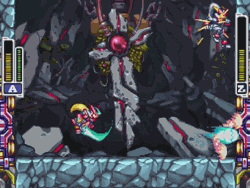 1997’s Mega Man Legends was, unfortunately, an evolutionary dead-end for the franchise, but Mega Man X4 (released the same year) allowed a complete Zero to costar with X (he was technically playable in X3, but he was more prototype than man). The Mega Man franchise always put a particular emphasis on distance and how easily ol’ Mega could be defeated by simply bumping into an enemy, so it seemed only natural when the franchise went all in on a character that had more of an emphasis on close-range combat. And it was a change for Zero as much as anyone else! Zero used to be able to slash opponents from a distance with an armbuster and flying cut, but now he was limited to a sword’s length for combat. And it worked! Many preferred playing as the up close and personal Zero in X4 and future X titles, so it was little surprise when it was time for…
1997’s Mega Man Legends was, unfortunately, an evolutionary dead-end for the franchise, but Mega Man X4 (released the same year) allowed a complete Zero to costar with X (he was technically playable in X3, but he was more prototype than man). The Mega Man franchise always put a particular emphasis on distance and how easily ol’ Mega could be defeated by simply bumping into an enemy, so it seemed only natural when the franchise went all in on a character that had more of an emphasis on close-range combat. And it was a change for Zero as much as anyone else! Zero used to be able to slash opponents from a distance with an armbuster and flying cut, but now he was limited to a sword’s length for combat. And it worked! Many preferred playing as the up close and personal Zero in X4 and future X titles, so it was little surprise when it was time for…
Mega Man Zero hit the scene in 2002. Once again, we had two evolutionary paths, with Mega Man Battle Network’s action/JRPG hybrid gameplay first emerging to great acclaim in 2001, and then Mega Man Zero curating the 2-D action a year later. MMZ could potentially be seen as a step back for the franchise, as singular Zero was technically more limited than X in his modular attacks, but, as the MMZ franchise evolved, Zero gained an arsenal that would put any other Mega Man to shame. And right from the beginning, it was clear that the point was never to give Zero another seventeen variations on Metal Blades, but create a smaller, tighter gameplay environment for an audience that had literally learned to walk alongside the little metal boy. Mega Man Zero’s Zero did not feel like the same upgrade we saw between Mega Man and Mega Man X, but it did offer a new, more intricate experience for the veteran Mega fan.
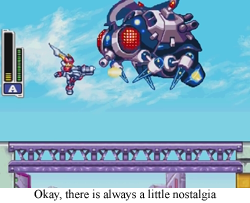 2006, four years (and ten games!) later, we received another two “sequel” franchises. Mega Man Star Force was our upgrade for Mega Man Battle Network, refining the basic gameplay and adding very important plot points about dinosaurs being killed by a lack of friendship. And, on the other side of the aisle, we got Mega Man ZX, the continuation of the Mega Man Zero franchise. In this world, the wars of Mega Man Zero eventually ended, and the heroes of that time were skinned alive and could now be worn like suits. Don’t worry! They’re still sentient “biometals”, so at least X, Zero, and all their frenemies can experience the joy/horror of being a fashion accessory for centuries! And the protagonist of Mega Man ZX watches their own personal Obi Wan die, which unlocks the ability to mega-merge the biometals of X of Z(ero). Thus, the titular Mega Man ZX is born, and they’ve got all the powers of Mega Man X and Zero. Finally! The lovers are united!
2006, four years (and ten games!) later, we received another two “sequel” franchises. Mega Man Star Force was our upgrade for Mega Man Battle Network, refining the basic gameplay and adding very important plot points about dinosaurs being killed by a lack of friendship. And, on the other side of the aisle, we got Mega Man ZX, the continuation of the Mega Man Zero franchise. In this world, the wars of Mega Man Zero eventually ended, and the heroes of that time were skinned alive and could now be worn like suits. Don’t worry! They’re still sentient “biometals”, so at least X, Zero, and all their frenemies can experience the joy/horror of being a fashion accessory for centuries! And the protagonist of Mega Man ZX watches their own personal Obi Wan die, which unlocks the ability to mega-merge the biometals of X of Z(ero). Thus, the titular Mega Man ZX is born, and they’ve got all the powers of Mega Man X and Zero. Finally! The lovers are united!
And, while the whole conceit of Mega Man ZX could have just been an excuse to give Zero a decent buster, the game really does feel like the conclusion of years of Mega Man and Zero games. Zero’s greatest strength was always its focused gameplay… but this left the hero feeling rather limited compared to his ancestors. Meanwhile, Mega Man had a thousand options for combat (or at least nine), but many of his adventures seemed overstuffed and… Sorry, the English language doesn’t yet have a phrase that translates to “too top spin-y”. But Mega Man ZX struck an excellent balance: the dedicated gameplay of the Zero franchise was here, but the options available to X were also fully integrated into every level. Mega Man ZX could “be”, essentially, Zero, or transform into a more mobile air-dasher. Or a water witch. Fireball bro. Cyber ninja. The hero’s got options! And each different form wasn’t just a matter of a slightly modified buster, they all offered unique mobility options, too. In a way, this is what was promised back in the ancient days of Rockman and his ability to mimic his opponents after a battle. Or maybe that’s just what was promised by Ruby Spears Mega Man…. Still! Whatever works!
And it must have worked well for somebody, because Mega Man ZX gained a sequel, Mega Man ZX Advent, the following year. And it advanced the Mega Man formula by being completely bonkers.
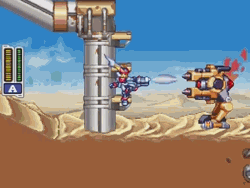 Mega Man ZX Advent eschews the typical mega-sequel plan by ejecting its previous protagonist right out of the gate. What’s more, this isn’t even a situation wherein the “ZX biometal” is immediately passed to the next generation or some other similar narrative trick to explain sprite reuse. No, the hero/heroine of Mega Man ZX Advent initially acquires the A Biometal, granting them the ability to wholly copy any given biometal or pseudoroid. What does this mean? It means you can play as the bosses! No more “got a weapon” or “can play as ZX-H” or whatever, you can just straight up emulate any given boss in the game! And it doesn’t matter if the boss “is too big for most areas” or “doesn’t have legs”, you can just turn into that fish monster on land if you really want to! Worst comes to worst, you just lose a life, so don’t worry about it. You’ll figure out that being a gigantic alligator monster all the time isn’t the best choice eventually.
Mega Man ZX Advent eschews the typical mega-sequel plan by ejecting its previous protagonist right out of the gate. What’s more, this isn’t even a situation wherein the “ZX biometal” is immediately passed to the next generation or some other similar narrative trick to explain sprite reuse. No, the hero/heroine of Mega Man ZX Advent initially acquires the A Biometal, granting them the ability to wholly copy any given biometal or pseudoroid. What does this mean? It means you can play as the bosses! No more “got a weapon” or “can play as ZX-H” or whatever, you can just straight up emulate any given boss in the game! And it doesn’t matter if the boss “is too big for most areas” or “doesn’t have legs”, you can just turn into that fish monster on land if you really want to! Worst comes to worst, you just lose a life, so don’t worry about it. You’ll figure out that being a gigantic alligator monster all the time isn’t the best choice eventually.
And, while it demolishes the tightness of Zero to make some sections of ZX Advent unerringly silly (“Quick! Turn into the twin cat-bears!”), what’s truly remarkable here is how much the player is trusted with these unwieldy toys. Mega Man Powered Up had been released the previous year, and it did its level best to make sure all of the playable Robot Masters were balanced and similar so Guts Man could (technically) conquer any challenge originally designed for Mega Man. There is no such equilibrium here: it’s a known fact that half the playable “party” cannot complete the game from beginning to end. Hell, a fraction of that group can barely even jump! But that doesn’t matter, because you can switch between forms at any time, and who needs to worry about whether Queenbee the Hymenopteroid can fit through a particular hallway? Just switch! The X button is right there! The ring menu means pausing the action isn’t too big of a deal, and you’ll be switching over to the appropriate pseudoroid with a few button presses.
And being able to cycle through a complete set of “Robot Masters” really felt like what Mega Man was always meant to be. Mega Man ZX Advent was the culmination of a full twenty years of Mega Man games.
And it turns out it really was the zenith of the franchise. There was nowhere to go but back.
The secret bonus of Mega Man ZX was the ability to play as Omega, the super-powered version of Zero that was supposed to be his original, unstoppable body (long story). The secret bonus of Mega Man ZX Advent was the ability to control Modal a (case sensitive), which…
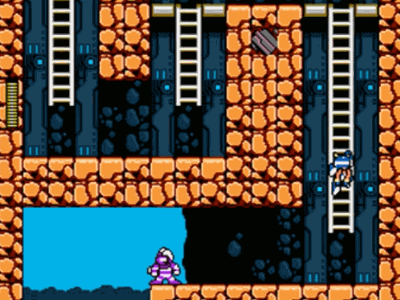
Looks a little familiar.
Model a was clearly a deliberate move, as the next Mega Man title to come down the pike was Mega Man 9, a retro title released in 2008. After years of Mega Man upgrading to match the graphics of the day, this was the first Mega Man title to fully embrace the NES aesthetic, and return to (faux) 8-bits. This was the first Mega Man to not try to upgrade old titles to modern sensibilities (like Mega Man X Maverick Hunter or Mega Man Powered Up) but take gameplay back to older standards while offering new and interesting experiences. But, retro or not, Mega Man 9 was an excellent game, and, while it may not have featured a “modern” Mega Man, it was the type of experience that could only be produced by people with decades of experience in the genre.
Which is great, because Mega Man 9 was apparently the end of any experimentation in the franchise.
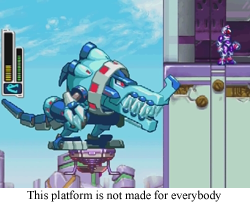 Since the release of Mega Man 9, we’ve seen Mega Man 10 (another retro title) and Mega Man 11 (something a little more modern). Aside from that? Nothing. No Mega Man X, Mega Man ZX, or Mega Man Battle Network. No Mega Man: Ultra Plus or whatever could have been next for the franchise. Mega Man 9’s success seemed to cement the concept that gamers just want classic, unchanged Mega Man, and that’s what Capcom is going to keep cranking out. We’ve seen about seventeen different rereleases of Mega Man 3, but nary a peep about Mega Man Legends 3.
Since the release of Mega Man 9, we’ve seen Mega Man 10 (another retro title) and Mega Man 11 (something a little more modern). Aside from that? Nothing. No Mega Man X, Mega Man ZX, or Mega Man Battle Network. No Mega Man: Ultra Plus or whatever could have been next for the franchise. Mega Man 9’s success seemed to cement the concept that gamers just want classic, unchanged Mega Man, and that’s what Capcom is going to keep cranking out. We’ve seen about seventeen different rereleases of Mega Man 3, but nary a peep about Mega Man Legends 3.
(And, yes, we could blame this all on Keiji Inafune, the godfather of Mega Man, leaving Capcom, but that ignores the fact that we have Mega Man 11, and it’s probable there is a reason Inafuking isn’t at Capcom anymore…)
Was Mega Man 9 a good game? Yes. Hell, it was amazing. By comparison, is Mega Man ZX Advent a bad game? Well, it’s not bad, but it is very sloppy compared to Mega Man 9 (or even Mega Man Zero 4). But it’s a lot of fun, and its experimental side is arguably what Mega Man fans have wanted all along. But since even more fans simply wanted good ol’ Mega Man, Mega Man 9 was the end of the franchise’s 20 years of experimentation. Mega Man 12 may be allowed to have a gimmick or two, but it better be the OG Mega Man, or it ain’t getting greenlit.
Mega Man 9 is my favorite game that murdered its own franchise’s creativity.
And Mega Man ZX Advent is my favorite game where you can play as Bifrost the Crocoroid.
FGC #481 Mega Man ZX Advent
- System: Nintendo DS initially, and now available for PS4/Switch via the Mega Man Zero/ZX Collection. This game was actually chosen by Random ROB a while ago, but I decided to hold off for the modern collection. And it’s good!
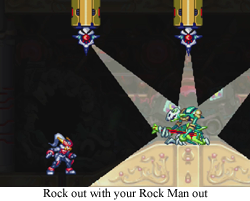 So you spent an entire article bitching how Capcom ignores the experimental Mega Man titles, and they just released one of the experimental Mega Man titles? Yes. Shut-up.
So you spent an entire article bitching how Capcom ignores the experimental Mega Man titles, and they just released one of the experimental Mega Man titles? Yes. Shut-up.- Number of players: Grey or Ashe, but only one at a time.
- Favorite Pseudoroid: Vulturon the Condoroid is a heavy metal vulture that summons robot zombies and flies through the air strumming his murderous electric guitar. Just… just how are you supposed to compete with that? Block Man can’t touch that with a ten foot block.
- Second Runner-Up: But all of the pseudoroids are amazing in this game. It would have been the easiest thing in the world to just phone in a number of Robot Masters that are all basic variations on a theme (like the Guardian Quartet), but we’ve got giant bees dragging around enormous hives and twin dog monsters and Metal Sonic and… Well, the list goes on for a while.
- Say something mean: The empty rooms that can be uncovered but won’t activate until you speak to the right random Ranger to initiate a sidequest are the absolute worst. The fact that there are like 50 “golden skulltula”-style monsters to hunt down, and the quest giver is tucked away in one of the final levels is somehow even beyond the absolute worst. Some kind of… Mega Worst.
- An end: Complete with the secret ending, the finale of Mega Man ZX Advent sets up a sequel featuring evil biometals, a turncoat leader, and an uncertain future that we know will culminate with Tron Bonne running around a sunken world. But what happens next? Who knows! Like Mega Man Legends, this branch of the Mega Man franchise never made it to a full trilogy, so here we sit waiting for more.
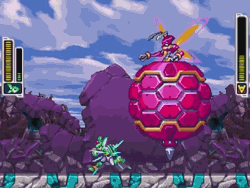 Did you know? Chronoforce the Xiphosuroid, the horseshoe crab-looking pseudoroid that can control time, is named for the Xiphosura order, which includes the Tachypleus tridentatus aka kabutogani. And that’s where we get the name for the Pokémon, kabuto.
Did you know? Chronoforce the Xiphosuroid, the horseshoe crab-looking pseudoroid that can control time, is named for the Xiphosura order, which includes the Tachypleus tridentatus aka kabutogani. And that’s where we get the name for the Pokémon, kabuto.- Would I play again: Did I mention I like playing as the giant crocodile monster? Because I very much enjoy playing as the giant crocodile monster.
What’s next? Random ROB has chosen… Gradius V for the Playstation 2! Keep your options open, Vic! Please look forward to it!
[…] only marginally qualifies as original, as she was literally a clone of another (male) character. Mega Man ZX and ZX Advent gave us a few heroic women… but it was very easy to play through a version of those games where […]